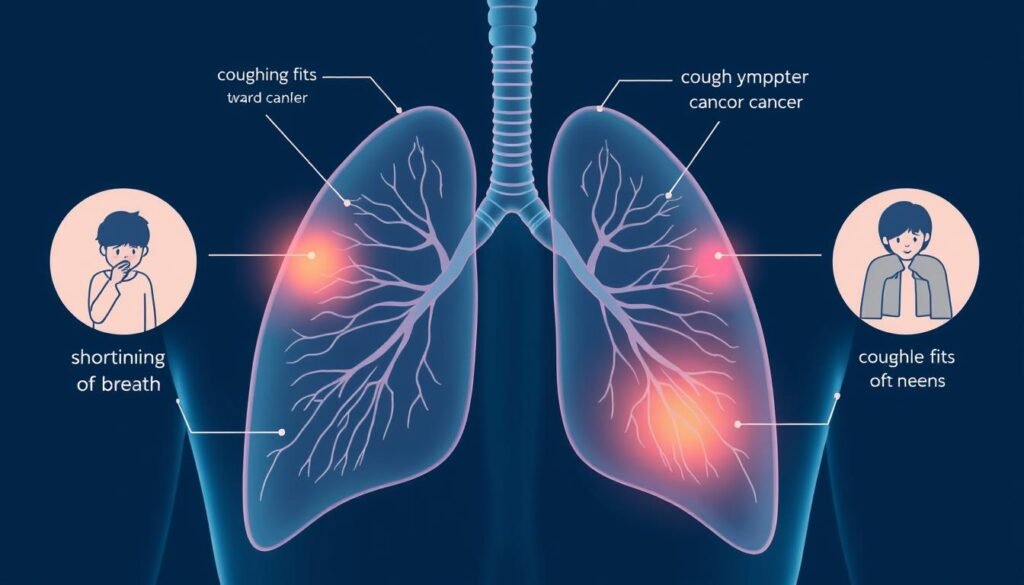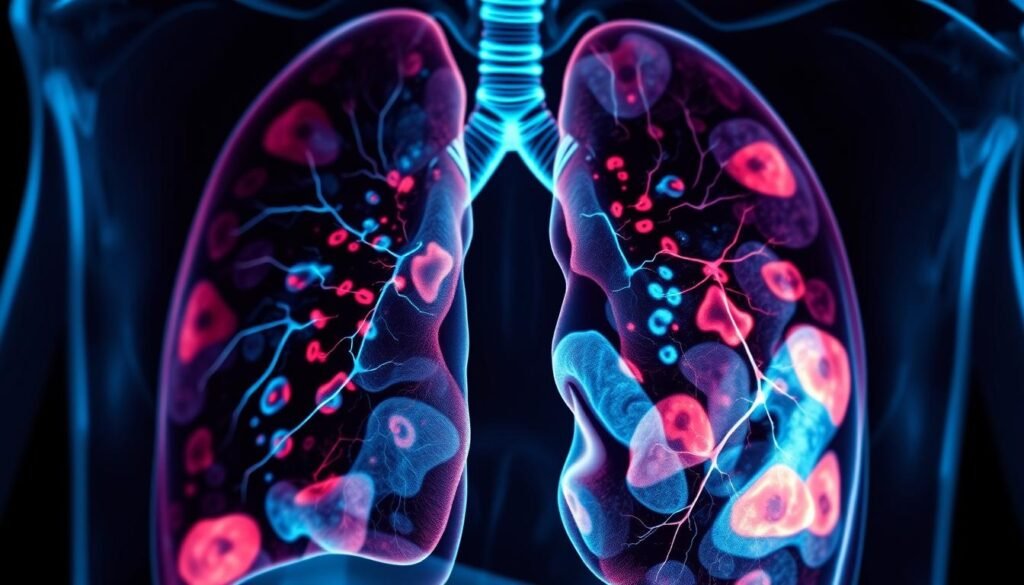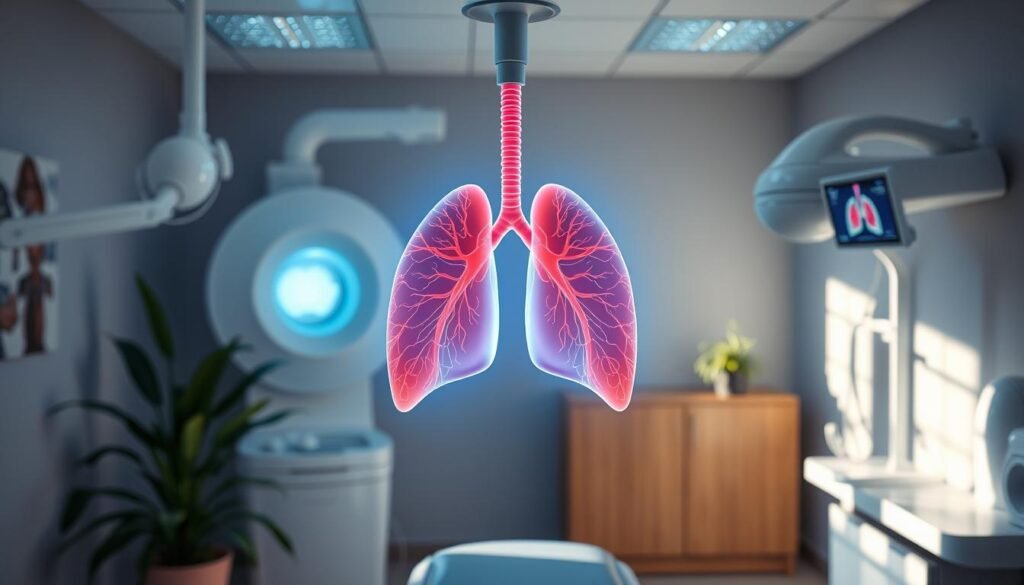Lung cancer is the second most common cancer in the United States. However, many don’t know the early signs. It’s vital to catch it early because it often doesn’t show symptoms until it’s advanced. Look out for a cough that lasts more than eight weeks, unexplained weight loss, and chest pain. These signs are crucial for early detection and treatment.
Understanding the importance of early detection of lung cancer is key. By knowing what to look for, you can seek advice from a doctor sooner. This early action could lead to a timely diagnosis and better chances of beating the disease.
People who smoke a lot are at a greater risk for lung cancer. That’s why it’s so important to know the warning signs. Recognizing them early could save lives and greatly improve the quality of life for those affected.
Key Takeaways
- Lung cancer is often diagnosed late due to subtle early symptoms.
- A persistent cough lasting more than eight weeks can be a sign.
- Unexplained weight loss or chest pain may indicate underlying lung illness.
- Routine screenings can significantly improve early detection rates.
- High-risk individuals should stay alert for changes in their health.
Understanding Lung Cancer Symptoms
Lung cancer shows many symptoms, which might not be noticed early on. Often, people confuse them with other breathing problems. Knowing these signs leads to early checks.
Common Symptoms of Lung Cancer
Finding lung cancer early is key to better treatment outcomes. Symptoms that could mean lung cancer include:
- Persistent or worsening cough
- Coughing up blood
- Chest pain
- Hoarseness
- Loss of appetite and weight loss
- Shortness of breath
- Fatigue
- Chronic respiratory infections
- Wheezing and recurring pneumonia or bronchitis
Symptoms Specific to Non-Small Cell Lung Cancer
Non-small cell lung cancer has common symptoms but also some unique ones. Patients may experience:
- Fatigue
- Repeated respiratory infections
- Hoarseness
Small Cell Lung Cancer Symptoms
Small cell lung cancer symptoms get worse quickly, often with paraneoplastic syndromes. These may include:
- Paraneoplastic syndromes affecting multiple body systems
- Horner syndrome, causing drooping eyelids and unequal pupil size
- Superior vena cava syndrome, leading to upper body swelling and breathing difficulties
Knowing lung cancer symptoms helps in getting timely help, leading to better treatments. Each lung cancer type brings its own set of challenges and signs. It’s important to recognize these differences to get the right medical help quickly.
| Symptom Type | General Symptoms | Non-Small Cell Lung Cancer Symptoms | Small Cell Lung Cancer Symptoms |
|---|---|---|---|
| Common | Persistent cough, chest pain, shortness of breath | Fatigue, hoarseness, recurrent respiratory infections | Rapidly escalating symptoms, paraneoplastic syndromes |
| Severe | Coughing up blood, unexplained weight loss | Weight loss, loss of appetite | Horner syndrome, superior vena cava syndrome |
How Do You Detect Lung Cancer
Detecting lung cancer early is key for effective treatment. Knowing how to find it lets people get help before symptoms start. Screenings are very important for those at high risk.
Importance of Early Detection
Finding lung cancer early can really help with treatment. If found before symptoms, treatment might work better. Screening, especially for those at risk, can save lives.
Common Screening Methods
There are a few ways to check for lung cancer. These include:
- Chest X-rays: These are often the first step but can’t confirm cancer alone.
- Low-Dose Computed Tomography (LDCT): This is a yearly test for people 50 and up with a high risk from smoking, and it’s better at finding early cancer than X-rays.
- Biopsies: If tests show signs of cancer, doctors may take tissue samples with special procedures to examine further.
To understand more about lung cancer and how it’s found, visit here for details on detection and staging.
The Role of Lung Cancer Screening
Lung cancer screening is crucial for catching the disease early. This early detection allows doctors to treat patients more effectively. It improves their chances of getting better. Knowing about and getting the right tests for lung cancer screening is key in fighting this deadly disease.
Types of Lung Cancer Screening Tests
Low-dose computerized tomography (LDCT) scans are the main screening tool. They can spot lung changes early and are particularly good at finding small, treatable cancers. Studies have proven that LDCT scans save lives by catching lung cancer early in high-risk people.
- Low-Dose CT Scans: The standard screening test for lung cancer, exposing patients to less radiation than traditional CT scans.
- X-rays: While not commonly used for screening, chest X-rays may help identify other lung conditions.
- Follow-Up Imaging: Additional tests may be required if the LDCT findings are inconclusive.
Who Should Be Screened?
Yearly LDCT screenings are advised for those 50 to 80 years old who smoked a lot over the years. Specifically, if they smoked 20 pack-years or more. This includes people who still smoke or those who quit in the last 15 years. Screening these individuals is more likely to find lung cancer early.
Screening is especially suggested for:
- Individuals in good health who can undergo surgery and other treatments if lung cancer is detected.
- Older adults who are long-time smokers without any signs or symptoms of lung cancer.
- People who may be experiencing other lung-related health issues or who are simply in routine health monitoring.
Places that do lung cancer screenings must have the right tools and know-how. This is important for giving care and following up after getting abnormal screening results. These actions are crucial for catching lung cancer early. They help lower death rates from the disease.
| Criteria | Screening Recommended | No Screening Recommended |
|---|---|---|
| Age | 50-80 years | Under 50 or over 80 |
| Smoking History | 20 pack-years or more | Less than 20 pack-years |
| Current Health Status | Healthy enough for treatment | Health issues excluding surgery |
Screening for lung cancer does more than just find the disease early. It also means thinking about the good it can do against the risks, like exposure to radiation from many tests. The goal is clear: to make patients lives better with careful screening plans.
Recognizing Early Warning Signs
Finding lung cancer early can make a big difference in treatment. Watch out for persistent coughing and chest pain. These warning signs shouldn’t be ignored because they could mean something serious.
Coughing and Chest Pain
If you have a cough that won’t go away, especially with chest pain, see a doctor soon. Noticing blood in your cough or a cough that gets worse can mean lung cancer. Lung cancer can cause chest pain that feels sharp or dull. This pain might get worse when you breathe deeply or cough.
Chest pain and coughing are seen in different kinds of lung cancer. They show that you need to be checked by a doctor.
Shortness of Breath and Wheezing
Feeling short of breath is a key sign of lung cancer. It happens when tumors or swelling block your airways. Hearing a whistle or rattle when you breathe could mean your airways are narrow.
If you often feel out of breath or hear wheezing, talk to a doctor soon. These signs can point to serious health problems.

| Symptom | Possible Implication |
|---|---|
| Persistent Coughing | Indicator of potential lung cancer or other serious condition |
| Chest Pain | May suggest irritation or tumors affecting lung tissues |
| Shortness of Breath | Possible airway obstruction or lung functionality issues |
| Wheezing | May indicate narrowed airways from tumor growth |
Lung Cancer Diagnosis Process
The journey to diagnosing lung cancer starts with a talk between the patient and doctor. They also do a full physical check-up. The doctor looks at symptoms, medical history, and risk factors at this time.
Initial Consultation and Physical Examination
This step involves a deep dive into the patient’s health history. Doctors look for symptoms like ongoing cough, chest pain, or breathing trouble. These signs might lead to more tests for lung cancer. The physical check-up helps the doctor look for signs and talk about risks, such as smoking or being around harmful stuff.
Diagnostic Imaging Techniques
After the first check-up, imaging tests are key in finding lung cancer. Doctors often use chest X-rays and CT scans. A chest X-ray can show possible lung cancer signs. A CT scan gives more detail, showing how far the disease may have spread.
For clear results, doctors may need a biopsy if they see something worrying. They might use a needle biopsy or an EBUS to get tissue samples. These techniques help doctors decide on the best treatment plan.
| Diagnostic Imaging Technique | Description | Role in Diagnosis |
|---|---|---|
| Chest X-ray | A preliminary imaging tool to visualize lung changes | Identifies abnormalities suggestive of lung cancer |
| CT Scan | Detailed cross-sectional images of the lungs | Stages cancer and checks for spread to lymph nodes |
| PET Scan | Imaging that shows metabolic activity of cells | Pinpoints cancer location and assesses aggressiveness |
| Needle Biopsy | Collection of lung tissue via a needle | Confirms lung cancer diagnosis |
| Endobronchial Ultrasound (EBUS) | Ultrasound-assisted biopsy technique | Evaluates size and spread of tumors |
Understanding Lung Cancer Tests
Lung cancer tests are key in finding and diagnosing lung cancer. There are imaging tests and biopsy procedures. Both types are crucial for learning about how far the disease has spread and what treatments are best.
Imaging Tests: X-rays and CT Scans
Imaging is important to spot and study tumors in the lungs. The main imaging tests are:
- X-rays: They show abnormalities but might not give all details.
- CT Scans: These provide detailed images of the lungs for a closer look.
- PET Scans: These are often used with CT scans to show tissue activity.
Knowing the differences between these tests helps doctors choose the right one for each patient. For instance, X-rays are a first step, but CT and PET scans offer a closer look for accurate diagnosis.
Biopsy Procedures and Their Importance
The lung cancer biopsy is essential for confirming cancer and identifying its type. There are several biopsy methods:
- Needle Biopsies: A thin needle gets tissue samples, with imaging for guidance.
- Bronchoscopy: A tube takes samples from the airways in a low-risk process.
- Mediastinoscopy: Samples are taken from lymph nodes via a small cut in the neck.
- Thoracoscopy: This lets doctors see and take samples from the lungs, sometimes with video help.
These tests are ciritcal not just for diagnosing cancer, but also for planning treatment. A precise diagnosis at a specialized center improves the outlook and helps find the right treatment.

Risk Factors for Lung Cancer
It’s vital to know the risk factors for lung cancer to stop it early. Smoking is the biggest cause. It greatly increases the chance of getting lung cancer. Other things like the environment and genes also play a part.
Major Risk Factors: Smoking and Environment
Smoking is behind about 80% of lung cancer deaths. It’s the top risk factor. Smokers are more likely to get all types of lung cancer. This is especially true for small cell lung cancer (SCLC). Being around other harmful things can also raise your lung cancer risk.
- Radon gas: This gas from the ground is the second main cause of lung cancer in the U.S. It mostly affects people who don’t smoke.
- Asbestos: If you’re around asbestos, you’re more likely to get lung cancer. This risk goes up if you smoke, too.
- Air pollution: Pollution causes 1% to 2% of lung cancer deaths. It’s a bigger problem in cities.
- Occupational hazards: Things like arsenic and diesel exhaust in some jobs can make lung cancer more likely.
- Previous radiation therapy: If you’ve had radiation for other health issues and you smoke, your risk is higher.
Genetic and Lifestyle Considerations
Genes matter in your cancer risk. Having lung cancer in your family means you’re more likely to get it. If a close family member had lung cancer, your own risk could double.
| Factor | Description | Impact |
|---|---|---|
| Smoking | Primary cause of lung cancer deaths. | Approximately 80% of cases. |
| Radon Gas | Second leading cause, particularly for non-smokers. | Accounts for about 30% of lung cancer deaths in non-smokers. |
| Asbestos | Workplace exposure increases risk. | Linked to 70-80% of mesothelioma cases. |
| Air Pollution | Urban environments expose individuals to harmful pollutants. | Minor contributor, yet concerning. |
| Family History | A history of lung cancer in close relatives raises risk. | Twice the likelihood for those with one affected relative. |
Consistent Monitoring and Check-Ups
Getting regular health checks is super important for catching lung cancer early. It’s key for people who are at higher risk of getting lung cancer. Getting a low-dose CT scan every year can help find lung cancer early, even before symptoms show up.
Regular Health Checks and Their Importance
Regular health checks are super important for spotting signs of lung cancer early. Catching it early means better options for treatment and a better chance of getting better. People who have smoked a lot (20-pack-year smoking history) and are between 50 and 80 should get checked every year. These checks are a big part of taking care of your health every year.
Discussing Symptoms with Healthcare Providers
Talking openly with your doctor about any health changes is crucial. If you’re coughing a lot, can’t catch your breath, or have chest pain, tell your doctor. Talking about these symptoms early on can help doctors act fast to take care of you. This kind of talk makes your care better because it’s based on teamwork, which might help spot lung cancer early.

| Health Check Frequency | Recommended Actions | Benefits |
|---|---|---|
| Annual | Low-dose CT scans for high-risk individuals | Early detection of lung cancer |
| Bi-annual | Discuss concerning lung cancer symptoms | Enhanced treatment options |
| As needed | Follow-up tests and imaging | Timely management of lung health |
Emotional and Psychological Impact of Lung Cancer
Getting diagnosed with lung cancer affects individuals and their families deeply. They might feel anxious or depressed. Finding ways to handle these feelings is key.
Facing the Diagnosis: Coping Strategies
Patients find different ways to ease their emotional stress. They may:
- Taking an active role in treatment decision-making.
- Seeking credible information regarding their condition and treatment options.
- Exploring alternative therapies such as yoga or meditation.
- Engaging in psychotherapy sessions.
- Reaching out to support networks.
- Maintaining physical health through exercise and proper nutrition.
About 1 in 8 lung cancer patients might feel depressed, with women at greater risk. Over 13% of women with this illness get major depressive disorder. Younger patients often struggle more emotionally.
Support Systems for Patients
A strong support network is crucial for dealing with lung cancer. Having family and friends around helps a lot. There are also patient groups and local help available.
Caregivers also experience a lot of stress, sometimes even more than the patients. It’s important to look after their mental health too. Help like the National Suicide Prevention Lifeline and counseling can support both groups.
Emotional well-being and quality of life are closely linked in lung cancer patients. Checking for emotional problems early can help improve mental health over time. A supportive community is vital for healing.
For further insights on the relationship between emotional well-being and lung cancer diagnosis, read more here.
Latest Advances in Lung Cancer Detection
New methods for finding lung cancer are making a big difference. They use new imaging tech and look for special biomarkers. These methods aim to spot the disease early. This lets doctors act fast to help save lives.
Innovative Imaging Technologies
Now, we use low-dose CT scans to find lung cancer better than before. These scans see more than old chest X-rays do. They can find tumors early when it’s easier to treat them. People over 50 who have smoked a lot should get checked every year.
The US Preventive Services Task Force agrees. They say adults 50 to 80 who smoke or quit recently should also get screened yearly.
Emerging Biomarkers in Lung Cancer Diagnosis
New biomarkers are becoming key in spotting lung cancer early. They help doctors choose the best treatment for each person. Liquid biopsies are a big breakthrough. They are a new way to test for cancer without surgery. This could change how we find and watch lung cancer.
Doctors are always finding better ways to fight lung cancer. They work together to improve how we find and treat it. For more on the latest in lung cancer, check out this resource.
Conclusion
Finding lung cancer early is key to better survival chances and treatments. About 224,000 new cases and 158,000 deaths from lung cancer were estimated in 2016 in the U.S. Knowing early signs of lung cancer boosts survival rates greatly. The 5-year survival rate stands at about 18%. This is much lower than for breast or prostate cancer.
By knowing lung cancer symptoms and risks, people can take early action for their health. A major study showed that low-dose CT scans lower death rates by 20% in high-risk groups. This highlights the value of effective screening. The U.S. now suggests LDCT scans for those at high risk. It’s vital for qualified people to use this screening option.
With advances in technology and lung health knowledge, keeping track of our health is crucial. Regular check-ups help people deal with lung cancer more successfully. Staying informed and monitoring health is key in the fight against lung cancer. It helps achieve the best outcomes for those affected.